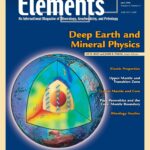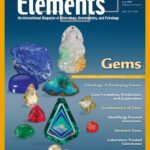
Deep Earth And Mineral Physics, June 2008, Vol. 4, No. 3
June 28, 2024
Gems, June 2009, Vol. 5, No. 3
June 28, 2024Bentonites – Versatile Clays, April 2009, Vol. 5, No. 2
$20.00
Of all naturally occurring clays, bentonites are arguably the most interesting, versatile and useful. This issue of Elements describes how these fascinating materials occur and how they are used in all manner of applications.
Bentonites – Versatile Clays
April 2009, Vol. 5, No. 2
Of all naturally occurring clays, bentonites are arguably the most interesting, versatile and useful. This issue of Elements describes how these fascinating materials occur and how they are used in all manner of applications. Composed predominantly of swelling minerals (smectites) and formed mainly from the alteration of volcanoclastic rocks, bentonites are used by geologists for stratigraphic correlation. Bentonite deposits are mined worldwide as they are commercially very valuable. Because of their physicochemical properties, bentonites are used in a wide variety of industrial applications, including the drilling industry, foundries, civil engineering, adsorbents, filtering, etc. Recent formulations of polymer– smectite nanocomposites have been used in industry to make new materials with amazing properties and diverse applications. Bentonites play an important role in the protection of the environment from industrial waste and pollutants and have also been used in medical applications in human health.
Why You’ll Love Elements Magazine:
- Expert Contributors: Articles written by renowned researchers in the field of geoscience.
- Engaging Content: Join a community of readers who are passionate about Elements.
- Exceptional Quality: Each issue is printed on high-quality paper with stunning visuals and detailed illustrations that bring complex scientific concepts to life.
Order your copy of the April 2009 issue of Elements magazine today and find out about the versatile clays of bentonites.
Related products
-
Energy: A Geoscience Perspective, June 2007, Vol. 3, No. 3
$20.00The issue of energy resources in the future may be one of the most important in the 21st century. Future climate change and the ways to abate it while still supplying needed energy will impact future political relations, world economics, human health, and the environment.
-
Arsenic, April 2006, Vol. 2, No. 2
$20.00Arsenic is an element known throughout history as a classic poison. Currently, very small but highly significant concentrations of this element in drinking water supplies are causing massive health problems to many millions of people in some of the world’s poorest nations, and more localised sources related to mining and processing are also a concern.
-
Glasses And Melts: Linking Geochemistry And Materials Science, October 2006, Vol. 2, No. 5
$20.00Geological interest in studying melts stems from early recognition that melts play a fundamental role in determining the physical and chemical behaviour of magmas and magmatic processes. However, due to the inherent difficulties associated with working at high temperatures, much of the geological research over the last 30 years has used quenched melts or glasses as proxies for melts themselves.




